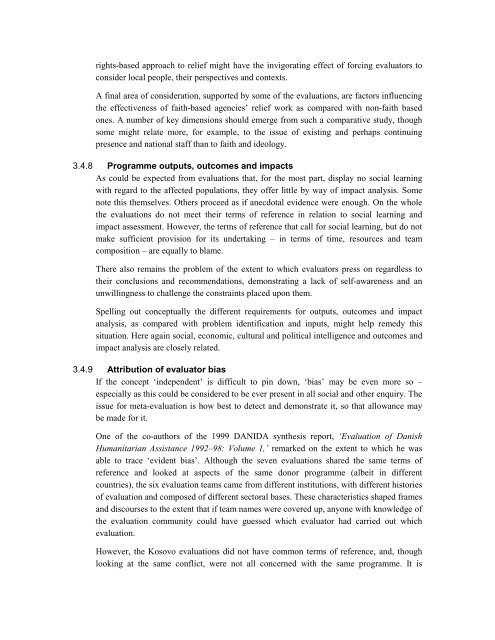Download PDF - ReliefWeb
Download PDF - ReliefWeb
Download PDF - ReliefWeb
You also want an ePaper? Increase the reach of your titles
YUMPU automatically turns print PDFs into web optimized ePapers that Google loves.
ights-based approach to relief might have the invigorating effect of forcing evaluators to<br />
consider local people, their perspectives and contexts.<br />
A final area of consideration, supported by some of the evaluations, are factors influencing<br />
the effectiveness of faith-based agencies’ relief work as compared with non-faith based<br />
ones. A number of key dimensions should emerge from such a comparative study, though<br />
some might relate more, for example, to the issue of existing and perhaps continuing<br />
presence and national staff than to faith and ideology.<br />
3.4.8 Programme outputs, outcomes and impacts<br />
As could be expected from evaluations that, for the most part, display no social learning<br />
with regard to the affected populations, they offer little by way of impact analysis. Some<br />
note this themselves. Others proceed as if anecdotal evidence were enough. On the whole<br />
the evaluations do not meet their terms of reference in relation to social learning and<br />
impact assessment. However, the terms of reference that call for social learning, but do not<br />
make sufficient provision for its undertaking – in terms of time, resources and team<br />
composition – are equally to blame.<br />
There also remains the problem of the extent to which evaluators press on regardless to<br />
their conclusions and recommendations, demonstrating a lack of self-awareness and an<br />
unwillingness to challenge the constraints placed upon them.<br />
Spelling out conceptually the different requirements for outputs, outcomes and impact<br />
analysis, as compared with problem identification and inputs, might help remedy this<br />
situation. Here again social, economic, cultural and political intelligence and outcomes and<br />
impact analysis are closely related.<br />
3.4.9 Attribution of evaluator bias<br />
If the concept ‘independent’ is difficult to pin down, ‘bias’ may be even more so –<br />
especially as this could be considered to be ever present in all social and other enquiry. The<br />
issue for meta-evaluation is how best to detect and demonstrate it, so that allowance may<br />
be made for it.<br />
One of the co-authors of the 1999 DANIDA synthesis report, ‘Evaluation of Danish<br />
Humanitarian Assistance 1992–98: Volume 1,’ remarked on the extent to which he was<br />
able to trace ‘evident bias’. Although the seven evaluations shared the same terms of<br />
reference and looked at aspects of the same donor programme (albeit in different<br />
countries), the six evaluation teams came from different institutions, with different histories<br />
of evaluation and composed of different sectoral bases. These characteristics shaped frames<br />
and discourses to the extent that if team names were covered up, anyone with knowledge of<br />
the evaluation community could have guessed which evaluator had carried out which<br />
evaluation.<br />
However, the Kosovo evaluations did not have common terms of reference, and, though<br />
looking at the same conflict, were not all concerned with the same programme. It is
















![CynefinFramework final [Read-Only]](https://img.yumpu.com/19017304/1/190x135/cynefinframework-final-read-only.jpg?quality=85)